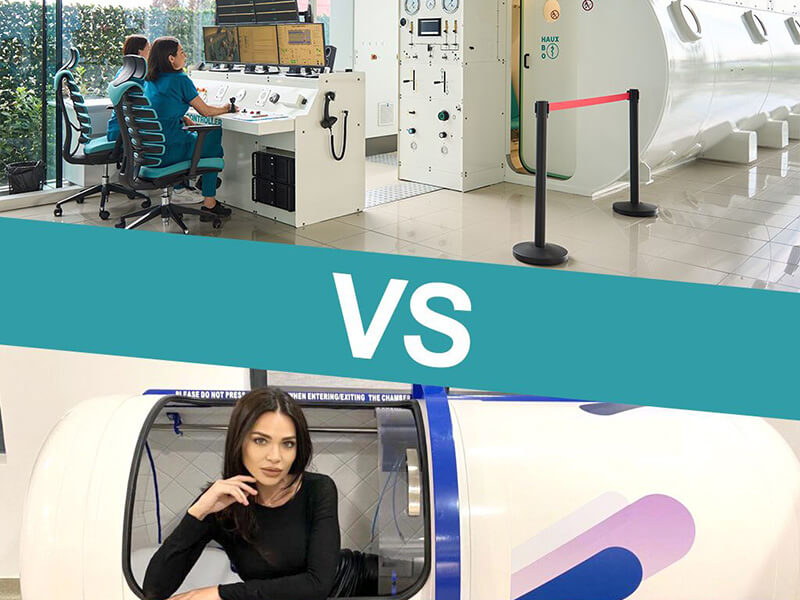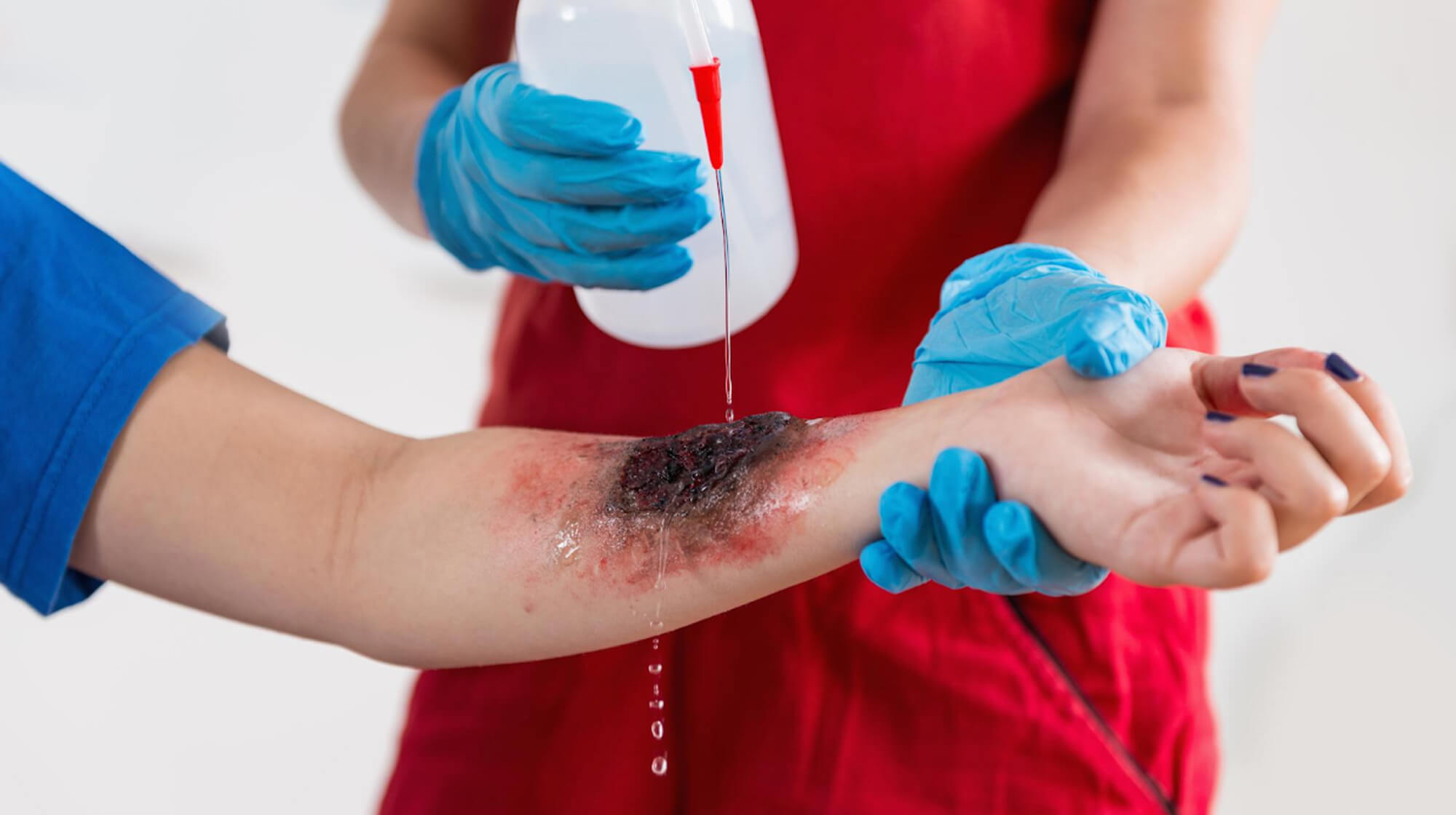
Article reviewed by: Dr. Sturz Ciprian, Dr. Tîlvescu Cătălin and Dr. Alina Vasile
Article updated on: 21-04-2025
Hyperbaric therapy: an innovation in the treatment of severe burns
The treatment of severe burns is not limited to local wound care. Behind every severe burn lies a chain of complex reactions: deficient tissue oxygenation, extensive inflammation, increased risk of infections, and a slowed healing process. Dressings, debridement, and antiseptic care are only part of the solution. This is where complementary therapies come into play, such as hyperbaric oxygen therapy, which targets exactly these deficits at the cellular and systemic level. Below you will find a detailed presentation of how hyperbaric therapy is used in the treatment of severe burns, from the current context in Romania to the mechanisms through which it works.
- Modern treatment of severe burns includes hyperbaric oxygen therapy
- Hyperbaric therapy for severe burns: past and present
- Burn centers in Romania and limited access to hyperbaric therapy
- Specific benefits of hyperbaric therapy in cases of severe burns
- Action mechanisms in cases of severe burns
- Number and frequency of hyperbaric therapy sessions in cases of severe burns
- How are mechanically ventilated or intubated patients treated in the hyperbaric chamber?
- Limitations and risks of hyperbaric therapy in cases of severe burns
Modern treatment of severe burns includes hyperbaric oxygen therapy
Severe burns are among the most difficult medical emergencies. We're not just talking about pain and surface wounds, but deep tissue damage, fluid loss, risk of infections, and complications that can last for months. Recovery is long, painful, and often unpredictable, especially when the burn covers a large part of the body or involves sensitive areas. That's why doctors are looking for solutions that help the body recover faster and more safely. One of the increasingly used methods is hyperbaric therapy: a treatment that has earned its place in protocols for severe burns.
More and more medical centers around the world have begun to include hyperbaric therapy in protocols for severe burns, precisely because studies from recent years show clear benefits: reduced infections, decreased hospitalization time, and accelerated skin healing. Doctors now view it as an essential tool in treating complicated cases. In some specialized units, therapy is started even within the first 24-48 hours after the accident, precisely to counteract the effects of hypoxia and inflammation as quickly as possible.
For a clear picture of the types of burns, classical treatments, and the role of hyperbaric therapy in this context, you can read more information here. If you want to understand in detail how hyperbaric therapy works, you can find useful explanations here. Next, we will focus on the connection between hyperbaric therapy and the treatment of severe burns.
Hyperbaric therapy for severe burns: past and present
Although many consider it a modern method, hyperbaric therapy has roots that go back to the 19th century. The first hyperbaric chambers were used for other purposes – primarily treating decompression sickness in divers. Only in the '60s-'70s did specialists begin to notice that burn patients exposed to hyperbaric oxygen showed faster healing and a lower risk of infections compared to those treated only by conventional methods. In the past, the problem was twofold: hyperbaric chambers were rare and difficult to access, and treatment costs were considered prohibitive. Today, things look completely different. Hyperbaric chambers are much more widespread, and medical protocols are much better defined.
In recent years, hyperbaric therapy has begun to be included more frequently in treatment plans for patients with severe burns. Hospitals in many countries have added hyperbaric chambers to intensive care or plastic surgery departments, precisely because studies show real benefits: patients recover faster, have fewer complications, and spend less time in the hospital. In some cases, treatment begins even within the first 24-48 hours after the accident, in parallel with dressings, antibiotics, or surgical interventions. The therapy does not replace the rest of the care, but significantly helps in critical phases. In Europe and the United States, more and more medical guidelines recommend it in complicated cases of burns, especially when there is risk of infection, deep skin damage, or a large burned surface. In parallel, equipment manufacturers have begun to develop safer and easier-to-use chambers, which has led to the expansion of use in more and more hospitals that, until now, did not have access to this treatment method. Even if there are still differences between countries regarding access to therapy, the direction is clear: hyperbaric oxygen therapy is becoming part of modern treatment for severe burns.
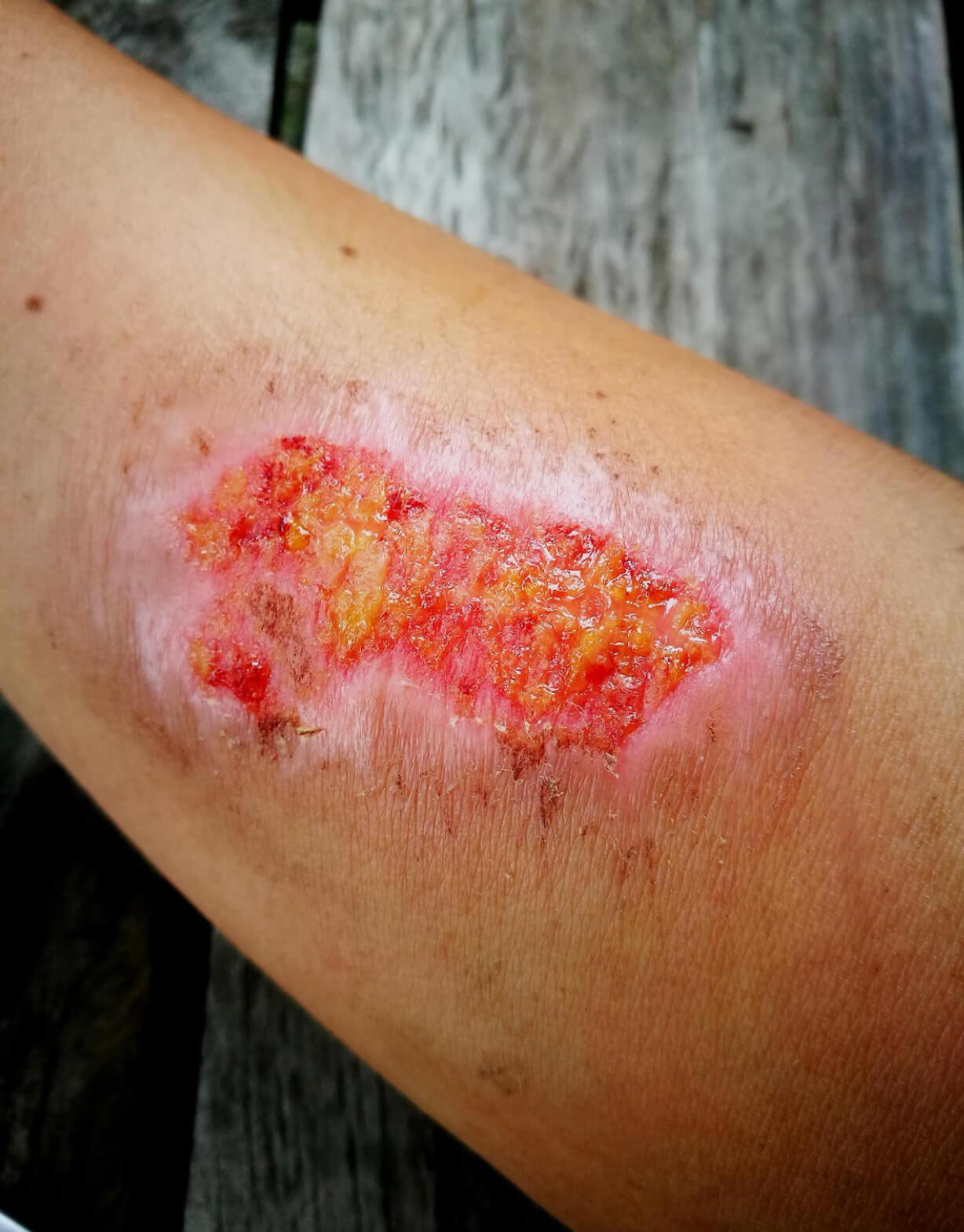
Burn centers in Romania, in the process of modernization and adaptation to European standards
The treatment of severe burns requires high-performance medical infrastructure and well-prepared multidisciplinary teams. In Romania, burn centers, units dedicated to the care of patients with extensive burns or burns located in critical areas, are in full process of modernization and expansion. Floreasca, Bagdasar-Arseni, and Timișoara hospitals already offer advanced treatments, and in recent years, important steps have been taken to increase the system's capacity to adequately respond to these complex emergencies.
After the Colectiv tragedy, authorities reassessed the need for a solid network of burn centers. Thus, projects were initiated to build three new units in Timișoara, Târgu Mureș, and Bucharest, with financial support from European funds and PNRR. Even though the process has been difficult, work is now underway, and plans include modern equipment, including hyperbaric chambers, for integrated and efficient treatment of critical patients. Meanwhile, existing centers have benefited from significant investments in equipment, ICU beds, and sterile spaces, a sign that the direction is clearly oriented towards improvement.
Besides physical infrastructure, efforts have also been made to increase the competence of medical teams. Training courses in partnership with European centers from France, Germany, and Belgium have trained Romanian doctors in new treatment protocols for severe burns. At the same time, emphasis has been placed on interdisciplinary collaboration: plastic surgeons, infectious disease specialists, nutritionists, and specialists in medical recovery collaborate to create personalized care plans.
In this context, hyperbaric oxygen therapy has become increasingly present in discussions about effective complementary treatments. In Cluj, the inauguration of the first hyperbaric chamber in a state hospital in Romania is planned, marking an important step in integrating hyperbaric therapy into the public health system. However, despite this good news, currently access remains limited in the public system, numerous private clinics in Romania collaborate with hospitals to offer burn patients access to hyperbaric therapy sessions. Also, specialists increasingly propose the inclusion of this therapy in national protocols for severe burns, especially due to demonstrated benefits: shortened healing time, reduced infections, and decreased risk of systemic complications.
Although the current system still has challenges, including staff shortages and lack of equipment in some county hospitals, the direction is promising. With the completion of new centers and the integration of innovative therapies, Romania is approaching European standards in burn care. And for patients, that means not just a better chance at life, but also a faster and more complete recovery.
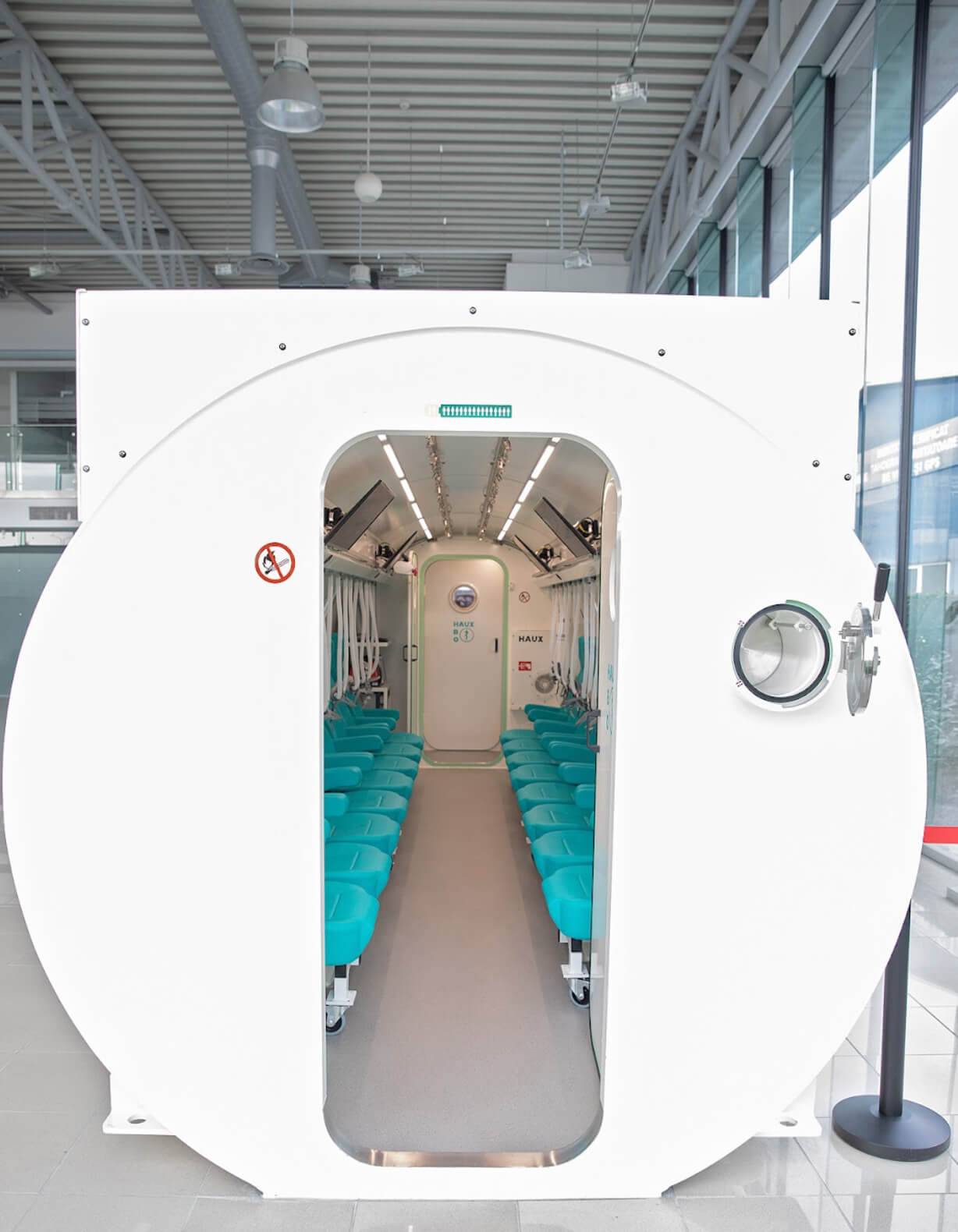
Specific benefits of hyperbaric therapy in cases of severe burns
Severe burns don't just affect the skin at the surface but destroy deep layers of tissue, compromise local circulation, and leave the body exposed to infections. In such cases, every hour counts, and oxygen becomes a critical resource for survival and recovery. Hyperbaric therapy offers a clear advantage: it rapidly increases the level of oxygen in the blood and transports it even to areas where blood vessels are destroyed. In patients with burns on large surfaces, this helps to limit the extent of lesions and supports faster tissue recovery. Many medical centers report that patients treated with hyperbaric oxygen need fewer days of hospitalization and develop dangerous infections, such as septicemia – one of the main causes of death in severe burn cases – less frequently.
Another important aspect in patients with severe burns is pain and inflammation control. Affected tissues release substances that can trigger a generalized inflammatory reaction, with risk of shock. Hyperbaric therapy sessions contribute to reducing inflammation and can help stabilize the patient's condition. In the long term, it also influences the quality of healing. More precisely, patients have a lower risk of deforming scars or keloids. There are also cases where, due to the positive effect on skin regeneration, the need for skin grafts decreases. Of course, it does not replace major surgical interventions, but it can make the difference between a complicated recovery and a more stable one. Practically, in the treatment of severe burns, hyperbaric therapy is not just "a plus," but can tip the balance towards a better evolution.
Action mechanisms in cases of severe burns
In cases of severe burns, the body quickly enters a state of crisis: local circulation is compromised, oxygen no longer reaches where it should, and remaining viable tissues are exposed to the risk of necrosis. Hyperbaric therapy intervenes exactly here. By increasing atmospheric pressure and administering pure oxygen, the blood transports a much larger amount of oxygen dissolved directly in plasma. Unlike oxygen bound only to hemoglobin, dissolved oxygen can penetrate even into areas where blood vessels are partially destroyed or collapsed due to the burn.
Another important mechanism is related to the anti-inflammatory effect. In extensive burns, inflammation does not remain local but spreads rapidly throughout the body, leading to systemic inflammatory response syndrome (SIRS). Hyperbaric oxygen therapy reduces the production of pro-inflammatory cytokines and limits the migration of leukocytes to already affected tissues. Essentially, it helps prevent the worsening of lesions and protects internal organs.
Besides these effects, therapy also impacts the risk of infections – a sensitive point in cases of severe burns. Anaerobic bacteria, responsible for severe infections, do not survive in the hyperoxygenated environment created by the chamber. Additionally, oxygen stimulates the activity of white cells, which directly supports the immune system, extremely weakened in patients with burns on large surfaces.
Last but not least, hyperbaric therapy accelerates the formation of new capillaries (angiogenesis) and supports fibroblasts to produce the collagen necessary for skin repair. In patients with severe burns, where the risk of deficient healing is high, this effect can considerably reduce healing time and diminishes the risk of long-term complications.
In cases of severe burns, each hour of delay can mean extension of lesions and worsening of the patient's general condition. Hyperbaric therapy is more effective the earlier it is started. Studies and clinical practice show that the ideal window to obtain the best results is within the first 24 to 48 hours after the accident. In this interval, therapy can quickly counteract severe hypoxia in burned tissues and can stop inflammatory cascades that threaten to transform into a dangerous systemic reaction.
For patients with extensive burns, early initiation of hyperbaric therapy not only limits additional tissue damage but also reduces the risk of major complications, such as invasive infections or multiple organ dysfunction syndrome. The more oxygen therapy is delayed, the harder the negative effects of hypoxia and inflammation become to control.
In the treatment of severe burns, hyperbaric therapy does not function in isolation, but is designed to complement standard interventions, including surgery. One of the most frequent questions is whether hyperbaric oxygen therapy can be combined with procedures such as skin grafts. The answer is yes, and often this combination brings better results than either method used separately. In practice, hyperbaric therapy can prepare the ground for a successful skin graft. By increasing tissue oxygenation and reducing inflammation, burned areas become better vascularized and more able to support graft integration. Also, the risk of post-operative infection decreases significantly, an essential factor especially in patients with extensive burns. Some specialists recommend hyperbaric therapy sessions both before and after applying the graft, precisely to support both the preparation of the area and the healing process.
Number and frequency of hyperbaric therapy sessions in cases of severe burns
In cases of severe burns, hyperbaric therapy is not a "single session" treatment. The protocol involves a variable number of sessions, adapted to the severity of burns and the body's response. Usually, patients with extensive burns benefit from 10 to 30 sessions, each lasting between 60 and 120 minutes.
The ideal frequency is one to two sessions per day in the acute phase, especially in the first days after the accident, when tissue oxygenation and inflammation control are essential. As the patient stabilizes and wounds begin to heal, the number of sessions can be reduced, depending on clinical evaluations.
The medical team always adjusts the schedule according to each patient's evolution, constantly monitoring vital parameters and how the body tolerates the treatment. Setting a rigid protocol does not work in cases of severe burns — the patient's reaction dictates the rhythm.
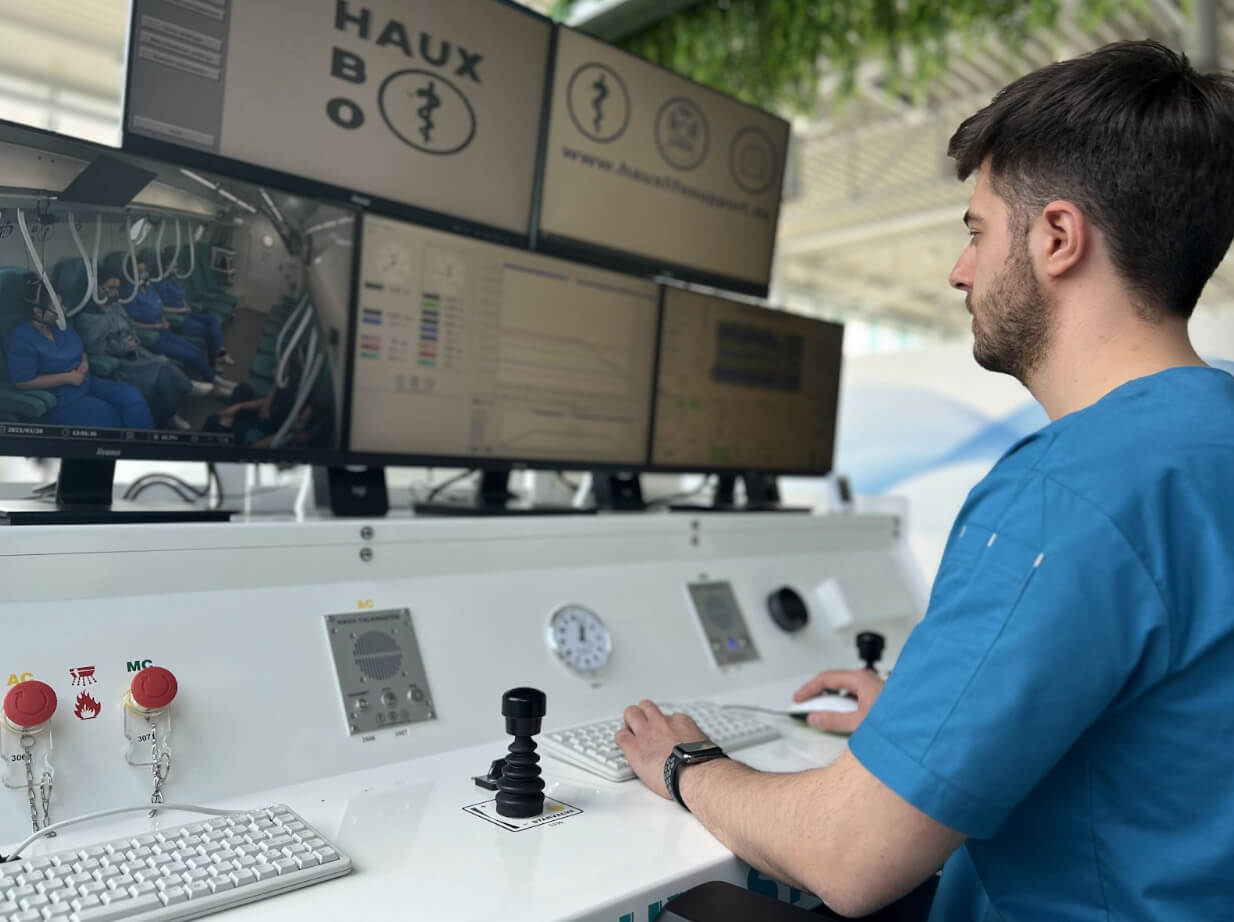
How are mechanically ventilated or intubated patients treated in the hyperbaric chamber?
A less-known but essential aspect when talking about patients with severe burns is that many of them end up intubated or connected to mechanical ventilation, especially if they have suffered burns to the respiratory tract or extensive skin surfaces. Integrating hyperbaric therapy in such cases requires careful coordination between the intensive care team and personnel specialized in hyperbaric medicine.
In multiplace hyperbaric chambers, such as the one at the Hyperbarium clinic, intubated patients can be treated under safe conditions, with continuous monitoring. Ventilators compatible with the hyperbaric environment are used, specially adapted to function at increased pressure. Medical personnel must adjust ventilation parameters (pressure, volume, oxygen) before the start of each session, to avoid barotrauma or sudden fluctuations in oxygenation.
Patient monitoring does not stop once the chamber is pressurized. In most modern centers, including Hyperbarium, vital parameters (heart rate, blood pressure, oxygen saturation) are monitored in real-time. Additionally, integrated telemedicine systems allow additional supervision by specialists outside the clinic, if needed.
In short, the presence of mechanical ventilation or intubation does not exclude hyperbaric therapy, but requires a high level of expertise and specific equipment. This is why the clinic's equipment and team preparation are important, because without these elements, risks may exceed benefits.
Limitations and risks of hyperbaric therapy in cases of severe burns
Although the benefits of hyperbaric therapy for patients with severe burns are clear, the treatment is not suitable for every patient and cannot be applied anytime, without restrictions. There are clinical situations where therapy must be postponed or even avoided. For example, patients with untreated pneumothorax (presence of air in the pleural cavity) cannot enter the hyperbaric chamber, due to the major risk of aggravation under pressure. Similarly, those with severe hemodynamic instability or with mechanical ventilation that is difficult to control may be considered too fragile for the procedure, at least in the acute phase.
There are also relative contraindications, such as uncontrolled epileptic seizures, certain inner ear conditions, or severe respiratory problems (e.g., advanced COPD). In the case of patients with extensive burns, where respiratory tract involvement is already frequent, doctors are obliged to carefully evaluate whether exposure to increased pressure does not worsen the situation.
In short, hyperbaric therapy is not a "one size fits all" treatment. Before each session, the patient is carefully monitored, and the decision to continue or adjust the protocol depends on the evolution of the general condition. The fact that there are contraindications does not negate the benefits, but emphasizes the necessity of a well-prepared medical team that knows when and how to use therapy correctly. A clear example is the Hyperbarium clinic, where hyperbaric medicine is practiced under the coordination of Dr. Sturz Ciprian, a physician with over 15 years of experience. The entire clinic staff is trained and certified at the European level. The clinic's doctors hold official competencies in hyperbaric medicine, according to the Order of the Minister of Health no. 418/2005, and always follow schemes validated by the European Committee for Hyperbaric Medicine (ECMH). Additionally, treatments are supervised in real-time through an integrated telemedicine system, which allows collaboration with specialists from international medical centers, for additional control of each case.
If you need additional information or want to find out if hyperbaric therapy is suitable in your case or that of a loved one, the Hyperbarium team is at your disposal. You can request an evaluation or appointment directly, to concretely discuss available options and applicable protocols.



